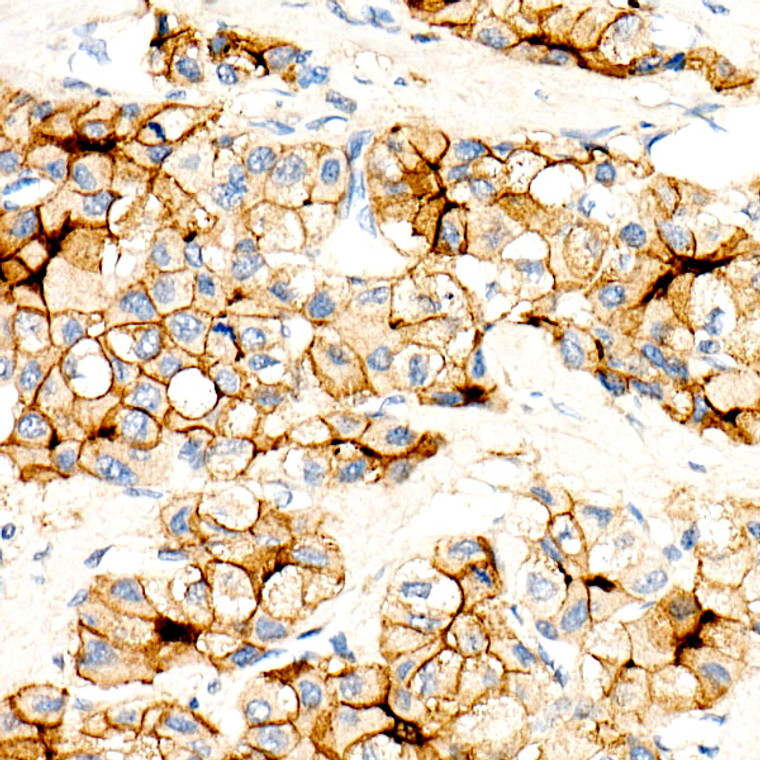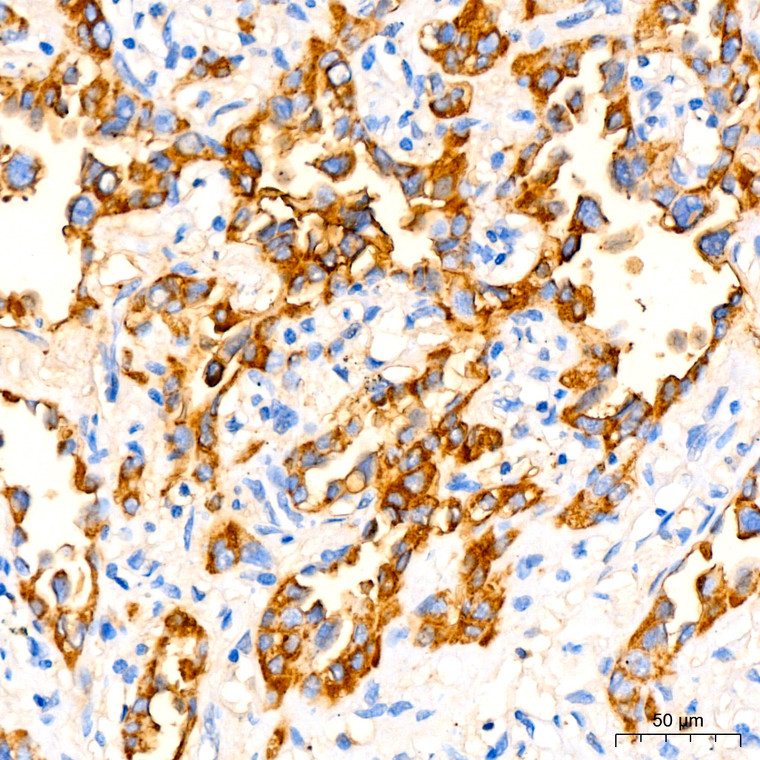| Host: |
Mouse |
| Applications: |
WB/IHC/IP |
| Reactivity: |
Human |
| Note: |
STRICTLY FOR FURTHER SCIENTIFIC RESEARCH USE ONLY (RUO). MUST NOT TO BE USED IN DIAGNOSTIC OR THERAPEUTIC APPLICATIONS. |
| Short Description: |
Mouse monoclonal antibody anti-CEACAM5 (35-685) is suitable for use in Western Blot, Immunohistochemistry and Immunoprecipitation research applications. |
| Clonality: |
Monoclonal |
| Clone ID: |
S1MM |
| Conjugation: |
Unconjugated |
| Isotype: |
IgG1k |
| Formulation: |
PBS with 0.01% Thimerosal, 50% Glycerol, pH7.3. |
| Purification: |
Affinity purification |
| Dilution Range: |
WB 1:500-1:1000IHC-P 1:50-1:200IP 1:50-1:200 |
| Storage Instruction: |
Store at-20°C for up to 1 year from the date of receipt, and avoid repeat freeze-thaw cycles. |
| Gene Symbol: |
CEACAM5 |
| Gene ID: |
1048 |
| Uniprot ID: |
CEAM5_HUMAN |
| Immunogen Region: |
35-685 |
| Immunogen: |
Recombinant fusion protein containing a sequence corresponding to amino acids 35-685 of human CEACAM5. |
| Immunogen Sequence: |
KLTIESTPFNVAEGKEVLLL VHNLPQHLFGYSWYKGERVD GNRQIIGYVIGTQQATPGPA YSGREIIYPNASLLIQNIIQ NDTGFYTLHVIKSDLVNEEA TGQFRVYPELPKPSISSNNS KPVEDKDAVAFTCEPETQDA TYLWWVNNQSLPVSPRLQLS NGNRTLTLFNVTRNDTASYK CETQNPVSARRSDSVILNVL YGPDAPTISPLNTSYRSGEN LNLSCHAASNPPAQYSWFV |
| Tissue Specificity | Expressed in columnar epithelial and goblet cells of the colon (at protein level). Found in adenocarcinomas of endodermally derived digestive system epithelium and fetal colon. |
| Post Translational Modifications | Complex immunoreactive glycoprotein with a MW of 180 kDa comprising 60% carbohydrate. |
| Function | Cell surface glycoprotein that plays a role in cell adhesion, intracellular signaling and tumor progression. Mediates homophilic and heterophilic cell adhesion with other carcinoembryonic antigen-related cell adhesion molecules, such as CEACAM6. Plays a role as an oncogene by promoting tumor progression.induces resistance to anoikis of colorectal carcinoma cells. (Microbial infection) Receptor for E.coli Dr adhesins. Binding of E.coli Dr adhesins leads to dissociation of the homodimer. |
| Protein Name | Carcinoembryonic Antigen-Related Cell Adhesion Molecule 5Carcinoembryonic AntigenCeaMeconium Antigen 100Cd Antigen Cd66e |
| Database Links | Reactome: R-HSA-163125Reactome: R-HSA-202733 |
| Cellular Localisation | Cell MembraneLipid-AnchorGpi-AnchorApical Cell MembraneCell SurfaceLocalized To The Apical Glycocalyx Surface |
| Alternative Antibody Names | Anti-Carcinoembryonic Antigen-Related Cell Adhesion Molecule 5 antibodyAnti-Carcinoembryonic Antigen antibodyAnti-Cea antibodyAnti-Meconium Antigen 100 antibodyAnti-Cd Antigen Cd66e antibodyAnti-CEACAM5 antibodyAnti-CEA antibody |
Information sourced from Uniprot.org
12 months for antibodies. 6 months for ELISA Kits. Please see website T&Cs for further guidance













